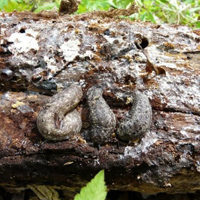Carolina Mantleslug
Scientific name: Philomycus carolinianus

Photo credit: Annegret Nicolai, reproduced from the version available on the Government of Canada website.
Status
Threatened
"Threatened" means the species lives in the wild in Ontario, is not endangered, but is likely to become endangered if steps are not taken to address factors threatening it.
Date added to the Species at Risk in Ontario List
January 26, 2022
Read the assessment report (PDF)
What it looks like
Carolina Mantleslug is a large slug with adults typically ranging from 6-10 cm in body length.
A large mantle covers the entire body of this slug. This mantle is the organ that is responsible for building the shells of snails, and while it is present on this slug, it does not actually create a full shell for this species. The mantle is usually ash-coloured with two central lines of black dots but may also have dark grey to brown marbling.
Where it lives
Carolina Mantleslug is a terrestrial air-breathing slug that prefers undisturbed wet and riparian areas of older-growth forests, with large amounts of well-decayed wood.
This slug is often found underneath loose bark on downed trees after rains and can often be spotted in forests containing large amounts of pine or aspen trees.
Carolina Mantleslug can be found across eastern North America, from Minnesota to Maine and south to Texas and Florida. Its northern range limit is Michigan, southern Ontario and Vermont.
Where it’s been found in Ontario
Within Ontario, the species occurs in southwestern Ontario at the following locations:
- Pelee Island in Lake Erie
- Grape Fern Woods in Lambton County
- Wheatley Provincial Park, Rondeau Provincial Park and Sinclair’s Bush in Chatham-Kent County
What threatens it
As with other native slugs and snails, Carolina Mantleslug has limited ability to move to new areas, leaving it susceptible to localized threats. The decline in Ontario is thought to be a result of decline in habitat quality for a variety of reasons, including:
- deforestation because of urban development and agricultural land uses
- climate change (extreme temperatures, droughts and flooding)
- prescribed burns
- invasive species
The amount and quality of available habitat for the species is expected to continue to decline because of anticipated extreme temperatures, droughts and flooding caused by climate change.
Action we are taking
Threatened species and their habitat is protected under Ontario’s Endangered Species Act, 2007.
Recovery strategy
A recovery strategy advises the ministry on ways to ensure healthy numbers of the species return to Ontario.
Read the executive summary and the full document (July 12, 2023).
Government response statement
A government response statement outlines the actions the government intends to take or support to help recover the species.
Read the government response statement (April 17, 2024).
What you can do
Report a sighting
Submit your observations of species at risk to the Natural Heritage Information Centre (NHIC), which is Ontario’s conservation data centre. Join the “(NHIC) Rare Species of Ontario” project in iNaturalist to make submitting your observations quick and easy.
Volunteer
Volunteer with species at risk programs, such as community science surveys, through your local nature club, a provincial park or other conservation organizations.
Be a good steward
- Private landowners have a very important role to play in species recovery. If you find species at risk on your land, you may be eligible for stewardship programs that support the protection and recovery of species at risk and their habitats. Learn more about the Species at Risk Stewardship Program.
- Invasive species seriously threaten many of Ontario’s species at risk. To learn what you can do to help reduce the threat of invasive species, visit:
Report illegal activity
Report any illegal activity related to species at risk to
Quick facts
- Carolina Mantleslug only occurs in the Carolinian Forest Region.
- Desiccation (water loss) is a threat to terrestrial snails such as Carolina Mantleslug. Members of the species may form huddles to help reduce water loss.
- Carolina Mantleslug possesses both male and female reproductive organs and all members of the species lays eggs. The species is able to self-fertilize to reproduce, although this may result in lower reproductive success.
- Carolina Mantleslug is a fungivore and prefers a diet of mushrooms and lichens.